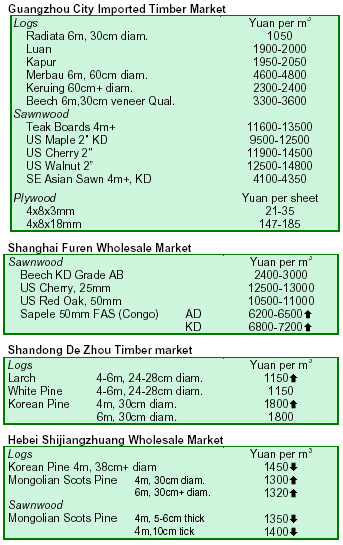|
US
Dollar Exchange Rates of 30th November 2006
China Yuan
7.833
Report from China
China imposes 10% export tax on solid wood flooring
On 27 October 2006, China¡¯s State Council Tariff Committee released a new policy on import and export
taxes, USDA reported. According to the new policy, solid wood flooring [HS Codes: 44091010 (Coniferous strips (blocks) for parquet flooring, not assembled) and
44092019 (Non-coniferous strips (blocks) for parquet flooring, not assembled)], several other wood products and
more than a hundred other tariff categories are subject to a 10% export, effective 1 November 2006.
Although solid wood flooring is eligible for VAT and duty free imported raw material, industry sources indicated that
China¡¯s solid wood flooring industry was in a difficult financial position. Analysts believe that competitive
factors would eliminate some small solid wood flooring manufacturers and that other processors would seek a
more diverse product mix (laminated wood flooring). China¡¯s solid wood flooring raw material is mainly sourced from South America, Russia and Asia.
Africa dominates timber imports through Zhangjiagang
Timber imports through Zhangjiagang Port amounted to 583,000 m3 valued at $139 million in the first three
quarters of 2006, down 14% in volume but similar in value compared with 2005. Timber imports came from Africa
(59.9% of Zhangjiagang timber imports), Oceania (31.3%) and Southeast Asia (7.5%), with those from Africa
continuously increasing while those from Southeast Asia in a declining trend. Imports of softwood timber was
comparatively minor (62,000 m3) due to high prices of New Zealand radiata pine and limited imports of Russian
timber, which mainly come through Taicang Port (see below).
Guyana and Suriname logs debut in Zhangjiagang
About 7,778 m3 of mixed logs from Guyana arrived at Zhangjiagang port for the first time in September this year.
The shipment featured 30 species, including greenheart, courbaril and purpleheart. Another shipment of similar log
species arrived from Suriname.
Prices for most tropical timber in Zhangjiagang market has been rising. Prices for PNG logs remained high. Prices for
PNG mersawa were at 2,500-3,000 per m3 while those for mixed logs exceeded 1,500 per m3. Prices for Gabonese
okoume surged to 4,000 yuan per m3 in August but eased somewhat in September.
Ocean imports of Russian logs soar
China¡¯s maritime imports of Russian logs rose 22% to 1.58 million m3 in January-July 2006, compared with last
year. Around 70% of the imports came through Taicang Port in Jiangsu Province (1 million m3), Lanshan Port in
Shangdong Province and some ports in Zhejiang Province. Analysts mention several reasons for the maritime import
increase. Firstly, imports of New Zealand radiata pine fell drastically in the last two years (down 24% in 2005) due to
high CIF prices. This species has been largely replaced by Russian pine in the East China market. Secondly, Taicang
Port, located in the Yangtze River delta economic zone, has become the distribution center for maritime imports of
Russian logs. Thirdly, the cost of maritime imports
became competitive after China changed its value-added tax policies.
Analysts foresee some trends influencing maritime timber imports from Russia. Firstly, log shipments from Russia would increase to the extent in which Russian timber is
used for plywood production. The tightening availability of poplar for plywood core in Jiangsu Pizhou and
Shandong Linyi production bases (10 million m3 of annual production) is gradually prompting demand for Russian
larch. Russian larch sell at prices similar to those of Chinese poplar and has a higher quality. Secondly,
Russian timber is increasingly substituting Myanmar timber in the Pearl River Delta region. China¡¯s timber imports from Myanmar fell drastically after a border trade
ban was imposed early this year (see TTM 11:11).


¡¡
|